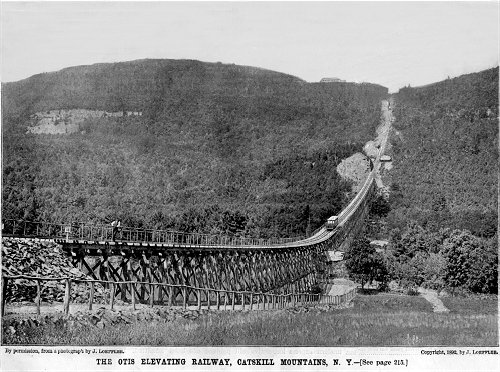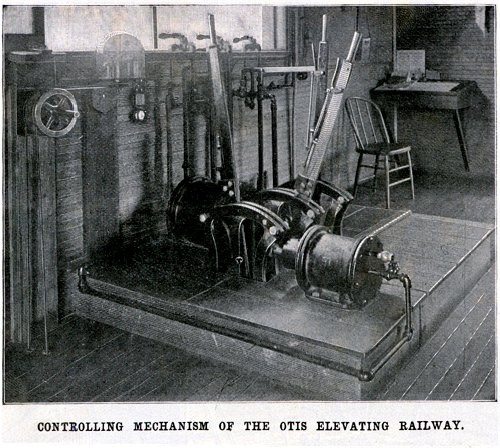THE OTIS ELEVATING
RAILWAY
from the Scientific American, October 5,
1895
The eastern end of the Catskills range has been a favorite
mountain resort for many years. Until within a short-time the
hotels on top of the mountain were accessible only by a
tedious stage ride up the face of the mountain, or by the
rather circuitous route of the Stony Clove railway running
from Phoenicia, on the Ulster and Delaware Railway, to the top
of the mountain.
Recently an inclined railway has been built up the side of
the mountain toward the valley of the Hudson, and extending
from Otis Station, on the Catskill Mountain Railway, nearly to
the top of the mountain. This railway is known as the Otis
Elevating Railway, having received its name from the firm of
Otis Brothers, the well-known manufacturers of elevator
machinery.
The road is 7,200 ft. long, with a rise of 1,600 ft. It
runs in a straight course down the mountain without any
lateral deviation, but is not a true inclined plane. It is
made up of four curves two of which are circular while two are
parabolic. This plan has been worked out by the engineer,
Thomas E. Brown, to secure, as far as possible, the balance of
the two cables used in moving the cars, the cables alone
weighing ten ton each..
The engines which operate the cables are located at the
upper terminus of the railway, within about three hundred feet
of the old Catskill Mountain House, which you see in the
general view. The engines are of the Corliss type, built by
the Hamilton Corliss Engine Works. They are seventy-five
horsepower each at one-fourth cut-off, the diameter of the
cylinders being twelve inches, the length of the stroke being
thirty inches. The shaft, which is common to both engines, is
provided with two brake wheels, which are each encircled by a
brake strap. The shaft also carries a pinion which engages a
spur wheel on a shaft of one of the cable drums. The driving
cable drum has a loose rim provided with a grooved periphery
which receives the cables, the rim being carried by friction.
The other cable drum simply supports the cables. The cables,
which are connected up parallel, are attached to one car, and
passing twice around the drums extend out of the engine house
around a sheave, thence to the other car.
|

|
The track, as will be seen by reference to the general
view, has three rails, the center one being common to both
cars, there been a separate outer rail for each car, except at
the turn-out, shown in the general view, about half-way up the
mountain. Here for a very short distance the track separate
into separate and distinct two-rail tracks. With this
arrangement, it will be seen that when 1 car goes up the other
must necessarily go down, and, so far as the cars themselves
are concerned, they balance each other.
The cars have a seating capacity of ninety passengers, a
caboose being provided for a proportionate amount of baggage.
The seats are like those used in the elevators of the Eiffel
tower, being constructed on a curve which enables the
passengers to easily adjust themselves to the different
inclinations of the railway.
To the ties on each side of the central rail are secured
heavy timbers which extend from one end of the railway to the
other, and upon each car is firmly attached a clutch capable
of of gripping this timber upon the top and sides. The clutch
is under the control of a governor which rolls on the top of
the timber. Any considerable increase in the speed of the
governor releases the clutch and causes it to be thrown
forcibly into the timber, thus instantly arresting the
downward motion of the car. The two cables are also attached
to a swivel plate upon each car, which is connected with the
clutch mechanism, so that should one of the cables fail, the
other will turn the swivel plate and cause the clutch to
engage the timber. The clutch can also be operated by hand at
the will of the conductor.
Upon the cable-driving drums is placed a strap break which,
together with the brakes on the engine shaft, is operated by
air pressure. The engines are provided with a link motion, and
the shifting of the engine may be effected by means of an air
cylinder in the tower above the engine room. In fact, all the
controlling mechanism may be operated by simply turning air
valves connected with the air brake system, and to insure the
stopping of the cars at the ends of the road a lever is
provided, which is moved by the car so as to throw into action
the engine-controlling levers and brakes, to immediately stop
the engine and to hold the cable securely in the position in
which it is stopped.
|

|
In the tower in front of the controller is a governor
driven by the engines below, which indicates the maximum speed
by closing an electric circuit and ringing a bell. A wire
extends from one end otf the road to the other for electric
signaling, and a telephone system has been provided, by means
of which telephonic communication maybe had between the cars
and between the cars and the stations at the ends of the road.
The passengers as they are carried up this road survey a
magnificent scene which can never be adequately produced on
canvas. For the details here presented we are indebted to C.
F. Parker, assistant
engineer.